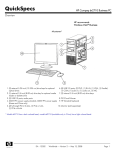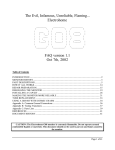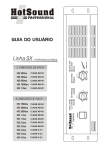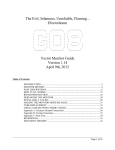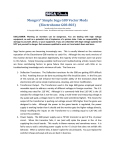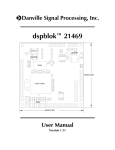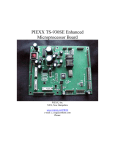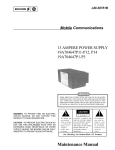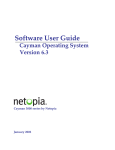Download Circuit Analysis and Improvements ot the
Transcript
Circuit Analysis and Improvements of the TS930S Power Supply Unit Switching off your rig can kill the driver transistors! F5VIM/DF7NT – Klaus SCHOHE - December 2011 1. Introduction In this document I present an analysis of the TS930S power supply unit (PSU) and propose some modifications, efficient and easy to implement, which strengthen the robustness of the 28.5V power supply to the PA. The PSU, as we know, is the perhaps only - weak point of this great radio which still is a reference in the high end class of HF transceivers. A lot of posts on internet report problems with the original PSU, sometimes resulting in killed driver transistors. In my rig, bought a couple of years ago from a fellow ham, I too observed some intermittent failures, sometimes exhibiting excess voltage which fortunately didn't lead to destruction of the driver transistors, expensive and difficult to find. In order to cure the failure and eliminate the intrinsic weaknesses of the original design, I investigated the PSU, using traditional circuit analysis, SPICE simulation and measurements on my rig. Along with this analysis, presented step by step, simple modifications will be proposed which enhance the performance characteristics of the PSU. In what follows, the important most point is the one which reveals an intrinsically (design related) regulation failure and exposes related possible failure mechanism. This is the subject of the rather intriguing statement I added to the title of this document. Before going into detail, I want to say a few words on two of the other modifications published: David's modification, W6NL, mainly is not related to the 28.5V supply. Nevertheless, for me implementing David's modification is an absolute must in order to get rid of the ugly original stabilization of 7.5V and 15V voltages by means of series resistors and zener diodes in the fan cabinet. Some years ago, I implemented David's improvement and am very happy with it. Implement David's modification if not done yet, you won't regret. Concerning the 28.5V supply, the modified PSU circuit proposed by Michael VK4AMZ without any doubt would have been my choice for it's elegance and intrinsic reliability. It provides state of the art regulation together with overcurrent and overvoltage survey associated to protecting thyristors. However, this board (probably intended to early TS930 transceivers) doesn't provide the 21.7V regulator which Kenwood implemented in later series. My transceiver (5M serial #) would need an additional board if replacing the original PSU unit by Michael's one in order to pilot the pass transistor of the 21.7V regulator. There is not a lot of space around the PSU and the transformer, and it would have been difficult to associate an additional board replicating the 21.7V regulation (Q6, D10, C13, R23, C12, and in particular the space consuming chemical capacitor C3 and the 6 pin connector #7 of the original PSU board). With regrets, I looked for an alternative solution to the VK4AMZ modification, and therefore investigated in detail the operation of the original design as detailed now. 2. General analysis of the 28.5 V regulator The schematic of the PSU and adjacent circuits is shown in Figure 1. The power supply unit delivers 28.5V to the PA, antenna tuner, LPF unit, meter bulbs, and the 21.7 V pass transistor. It also provides 21.7V, used to generate other voltages for the rest of the rig. The pass transistors Q1 and Q2 of the 28.5V supply are visible in the upper right part of figure 1. Q3 above the power switch is the pass transistor delivering 21.7V. Q6 is the driver for the 21.7V pass transistor. The voltage regulator for the 28.5V supply to the PA etc. is visible in the upper part of the PSU unit, constituted by Q1, Q2 and adjacent components. The PA is permanently connected to the right end of the 0.05Ω resistor R14; the voltage drop across R14 is provided to the signal unit via connector 6 of the PSU for the display of the PA collector current (ICA and ICB). The PSU voltage at point 28B (before R14) is supplied to the signal unit via ICA for display of VC at the meter. Q3 to Q5 serve for control of the PSU cooling fan. In the following, we will focus on the 28.5V regulator. Figure 1: Schematic of the TS930S power supply 1 The 28.5V regulator operates as follows: • The output voltage is sensed at point 28B via R7 and D8. The forward biased diode D8, the varistor D6 and the reverse biased zener diode D3 are subject to a current of about 10mA. In conjunction with R6 they define the emitter potential of Q2 to : VE-Q2 = Vout - approx. 15.3V • The potential difference of 15.3V subtracted from the output voltage, is the sum of the forward voltage in D8, of an about 2.1V drop in the varistor D6 at 10mA and of the zener voltage of D3. Consequently, any change of the output voltage induces an equal change in the emitter potential of Q2. • On the other hand, the base potential of Q2 is defined by the output voltage and the voltage divider constituted of R7, VR1 and R8. This potential is about 13.7V, so roughly half of the output voltage, thus providing about 0.5V of base emitter voltage VBE to Q2. A variation of the output voltage will affect the base potential by only half this value. If the output voltage decreases by for example 100mV due to increase of the load current, or by a drop in the main power supply voltage, the base potential of Q2 drops by about 50mV. Likewise, a 100mV increase of the output voltage (e.g. due to increased current gain of the pass transistors resulting from heating) leads to a 50mV increase of the base potential, and hence a 50mV decrease of VBE of Q2. In other words, while we provide the regulator with the full output voltage variation at the emitter of Q2, half of this variation is lost for VBE by the voltage divider for the regulator set point. 1 The NPN transistor Q2 is the first stage of the error amplifier in the regulation loop; its role is to compare the sample of the output voltage to the set point which defines the target voltage. As we saw, VBE of Q2 varies out of phase by about half of the output voltage variation. Consequently, the collector current IC of Q2 varies also out of phase. If the output voltage increases with respect to the voltage set point defined by adjustment of VR1, the collector current IC-Q2 decreases. The PNP transistor Q1, the second error amplifier stage is the driver for the pass transistors, it only amplifies the error signal provided by Q2. The transistor Q1 is polarized with a negative VBE voltage corresponding to the voltage drop across R2 a 47kΩ resistor. Therefore VBE of Q1 is proportional to the current flowing in this resistor. A decrease of the collector current IC-Q2 therefore also reduces the collector current of Q1, and hence leads to less current injection in the pass transistors. Consequently VCE of the pass transistors increases. This limits the output voltage variation to the regulator error voltage which is function of the total loop gain; the higher this gain, the more stable is the output voltage with respect to load current or input voltage variations. So far for the steady state operation principle. What do C5 and R22 serve for, and how does the regulator start? Right after switch on, the emitter and base potentials are zero, and therefore we might think that C5 is intended to give a "kick" to the base of Q2. I am not sure about this. First, the potential at C4 increases asymptotically to the value of the supply voltage with a time constant defined by C4 and R1, and moreover, the supply voltage itself also builds up as the two capacitors C8 and C9 (together 44000µF) get charged by the rectified AC voltage; taking into account the series resistances of the transformer and of the bridge rectifier, this process is quite slow. Consequently, we cannot consider that C5 provides a significant potential spike to the base of Q2. Secondly, to my understanding, both from conventional circuit analysis and from SPICE simulation 2 , the circuit starts through the residual off-state current in Q2. Of course in absence of a polarization VBE an ideal NPN transistor would not allow any current to flow as we apply about 40V to its collector. But a real transistor will. Due to the high value of R2, a quite small off state current in Q2 allows polarization of Q1, and therefore will start regulation. I simulated the circuit without C5 and didn't see any difference in the switch on transient behavior. 3 The same manner, we might think that R22 allows the circuit to start, providing polarization to the pass transistors. We will see later that indeed R22 has an influence, but definitely not the way we want. This resistor, without other modification, might even cause the destruction of the driver transistors; in point 3 we will analyze this potential dangerous effect in detail. As far as start-up of the circuit is concerned, again, I didn't see any difference in simulation with SPICE both with and without R22 connected. What about D7? At a first glance, we might attribute to this 33V zener diode a, exclusively protective role, i.e. a security function which consists in limiting the base potential of the pass transistors in case of a component break down in the error amplifier (e.g. a Q1 short). And this is what I first thought too. But investigating further, it turned out that even without any failure of whatever component, D7 may not prevents us from disaster. We will see - again in point 3 - what this is due to and how we can give D7 it's exclusive role of an "emergency break" as it should be. The base series resistors of the pass transistors R4 and R5 - partially - compensate disequilibrium in current and power distribution between both pass transistors. We'll see in the fourth part of this article that we can do better. 1 Some of you may already see a design weakness here, but this is not crucial for the security of operation. We will come back to this observation later when we speak about improvements of the PSU performance. 2 LT Spice can be downloaded as freeware at http://www.linear.com/designtools/software/ or run a Google search. 3 However, there is a little influence of C5 on the ripple rejection. Also, C5 may serve to prevent other effects (e.g. oscillation) which perhaps were observed with real world components during the test phase of the design. I didn't investigate this point further. 2 3. Regulation limitation and resulting potential danger for the driver transistors In this part I will come back to my observation of occasional overvoltage of the 28.5V output of the PSU. As said in the introduction, I observed some strange behavior of the PSU. Sometimes the meter lights shone brighter or flickerd somewhat randomly. At the same time, the VC-meter of the TS930S showed voltage in excess to 30 V. Of course, the first thing I did was to open the rig and disconnect the heavy red 28.5V lead to the PA. I then tested the PSU with dummy DC loads I had on hand, high wattage resistors and also 12V car bulbs in series. I noticed, with low load currents, that an overvoltage could occur after some time of heat up, while it was absent when the PSU was cold. Further on, I observed with these tests - that the PSU behaves as expected for a wide load range, - but at low load, or no load at all, the output voltage raised to almost 33V. Also, when I ran the PSU with the small yellow wire still connected to point 28B, I observed that - the voltage at this point went up to again about 33V for a couple of seconds after switching off the rig. First, I suspected a component failure, but whatever point I measured, everything seemed to be ok in steady state. I therefore simulated the circuit with LT Spice in order to check the operating points of the components more precisely against the corresponding values calculated by simulation, and also in order to verify if perhaps a component was driven to close to its rating, suspecting that perhaps some overheating could lead to the failure I observed. Again, everything was ok so far if at least about 1A of load current flew at the output. However, at low load, or no output current at all, the calculated operation points confirmed my experimental observation of excess voltage at the PSU output. The Figures 2 and 3 show the simulated circuit and I-V characteristics of the PSU, simulated with SPICE for the net labels indicated in red on the schematic. Figure 2: Design used for LT SPICE simulation of the the 28.5V regulator. (See the text for explanations regarding the models used.) Figure 3: Simulated V-I characteristics and compound base currents of the pass transistors of the original 28.5Vregulator for Iload = 0A … 12A. I concluded that something must be wrong by design. Therefore, I ran a simulation with a sweep of the load current from 0A to 12A, and it confirmed my experimental observation: • The PSU, by design, cannot regulate at low load conditions. Here is the reason why. 3 Remarks concerning the modeling: Simulation with SPICE is often hampered by the unavailability of SPICE models of the components. For this simulation I used the models of components as in the original design, excepted for: Q1 (BD140 model); Q2 (BC639 model); D6 (simulated by a 2.1V voltage source with internal resistance of 16Ω read from I-V characteristics in the datasheet of the SV-03Y varistor); D8 (1N4148 model and D3 (BZX84C12L model). The chemical capacitors C4, C6 and the two 22mF capacitors (denoted C8r and C9r in the schematic) are "real life" SPICE models, i.e. including parasitic elements (series inductance, parallel conductance, …). The simulation includes the 4.7kΩ resistor across C8r and C9r in the rig, but not shown in the TS930S main schematic (Figure 1). The load is simulated by a variable load I1 varied from 0 to 12A in 1mA steps as indicated by the SPICE directive. The source (in reality a rectified AC source) is modeled with a constant DC source, because LT SPICE doesn't allow time dependant sources (i.e. AC) in DC sweeps. The compound current of the two pass transistors is calculated simply by 2 x IR5. The compound base current of the pass transistors has a negative value, for by convention of the current node analysis we will perform later, the current is counted positively in the sense flowing toward the node. As can be seen from the black and blue curves, which respectively show the voltage-current characteristics at 28A/28B and after the 0.05Ω resistor, there is indeed a range, up to a load current of some hundreds of mA, where the voltage exceeds the 28.5V target voltage. • This simulation confirms that by design, there is a threshold of load currents below which the regulation doesn't work. Beyond this point, as expected, both voltages drop as the current increases, the blue curve (i.e. the voltage the PA "sees") showing the additional voltage drop in the 0.05Ω resistor. The popup window in Figure 3 indicates the voltages supplied to the PA unit at the 2A and 10A cursor positions. The slope, approx. -60mV/A, gives the differential resistance - 60mΩ - of the original PSU in this range. The differential resistance will be discussed in the forth part when we speak about improvements of the regulator performance. The collector voltage (red trace) of Q1 (i.e. the signal from the error amplifier of the regulator) shows the same overvoltage behavior for low load currents. Beyond about 110mA of load current, the collector potential of Q1 increases as expected, such as the base current of the pass transistors does (light green trace, right scale). Let us have a closer look: At the node C_Q1, the collector of Q1, the sum of currents must be equal to 0. IR4 and IR5 are the base currents in the pass transistors and are considered equal for the purpose of this analysis. By convention, currents are counted positively towards the node; currents effectively flowing away from the node therefore have a negative value. Consequently, according to Kirchhoff's law we have: IC-Q1 + IR22 + ID7 + 2 . IR5 = 0 The situation at node C_Q1 is shown in Figure 4, a simulation zoomed at the "strange" region of low loads. LT SPICE defines the directions of the currents according to its own rules. - At selection of the currents, ID7 and IR5 were effectively counted towards the node, but have a negative value. - For IR22 and IC-Q1 LT SPICE determines the values of currents flowing away from the node. The signs for the labels of the currents at the top of the diagram were set to respect the rule of counting positively currents flowing towards the node. As can be seen from the output voltage characteristic at point 28A/28B (black line) at this level of zoom, there are 3 distinct V-I dependencies: • a non linear V-I dependence for 0mA to 60mA output current • a linear range from 60mA to 110mA with a steep slope • beyond 100mA, an also linear V-I dependence, but with a much smaller slope. Figure 4: Node at Collector Q1, load range 0 - 300 mA Left scale: Output voltage (black), node potential (grey) Right scale: Node currents IR22 (blue), ID7 (red), IC-Q1 (turquoise) and sum of the base currents to the pass transistors (pink) - For cursor 1, see text. The latter corresponds to the normal (and expected) regime of the regulator we already saw in Figure 3. Looking at the currents we notice that in the lowest two ranges, i.e. up to 110mA, no significant collector current is supplied from Q1.(light green trace). 4 In this range of low output current, the current flowing to the pass transistors (pink trace) is balanced by the current in the zener diode D7 (red) and in R22 (blue) only. In both ranges overvoltage occurs. The absence of collector current of Q1 for Iload < 110mA provides evidence that the error amplifier doesn't control anything in this range of operation. • To my knowledge, this intrinsic effect (due to the design) of unregulated operation of the TS930S PSU wasn't reported yet 4 and published investigations most often suspect observed excess voltage to be due to some potential or real component failure. The three regimes of operation can be characterized as follows: Regime A – IZ controlled In the range up to 60mA, the current in the zener diode varies with the potential of the node, while the current in resistor R22 is almost constant. The current in the pass transistors and the output voltage essentially follow the I-V characteristic of the zener diode D7. Regime B – IR22 controlled In the range 60mA … 110mA, the potential of the node (about 0.5 V higher than the output voltage) is below the knee of the zener I-V charactersitic, the current in R22 varies while the current in the zener diminishes. Only R22 governs the V-I characteristic of the PSU. Therefore in this range the V-I characteristic is linear. Regime C – IC-Q1 controlled, regulated operation The threshold of the regulated regime (i.e. the onset of IC-Q1) occurs at a load current of approx. 110mA, while the current in R22 becomes constant. At the point of onset of the regulation, • IR22 is approx. 0.7mA (see cursor), • and the node potential at this point is about 29.1V. Care should be taken interpreting figures from this diagram: - First of all, as indicated above, some components differ from the real components used. And even if we have a model for the component in the circuit, characteristics of real components are subject to dispersion within tolerance ranges, in particular the current gain hFE of the transistors. Consequently, the steep linear range (Regime B) may extend to currents higher than expected from the simulation shown in Figures 3 and 4. - Secondly, as we know, the current gain of bipolar transistors increases with temperature and consequently the threshold for regulation onset shifts to higher output currents. If the point of operation is close to the limit between Regimes B and C, overvoltage may occur at higher temperatures 5 while it doesn't at lower ones. This, I guess, is the reason for my observation during testing with dummy DC loads that excess voltage occurred occasionally after warm up of the PSU, while for the same low current there was no overvoltage when it was cold. Before we come to the remedy, let us investigate my other, very strange observation of an overvoltage transient right after switching off the rig. Let us also think about the potential danger and failure modes triggered by this non regulated regime at low load conditions. • This will show that unlucky (but realistic circumstances) may lead to destruction of the driver transistors in the PA unit when switching off the rig. Analyzing the schematic of the rig we notice that the PA is connected permanently to the current sensing resistor R14. However, the 28.5V to the antenna tuner, LPF unit, meter bulbs as well as the 21.7V pass transistor are delivered through a contact pair of the power switch; in this switched lead I measured a current of 0.54A with meter lights and display dimmed. It is due to this switch why we observe an overvoltage at 28A, 28B as well as on the lead to the PA: Right after switching the rig off, the capacitors C8 and C9 – 22000 µF each – near the rectifier in Figure 1 are still energized to about 40V (I measured 39.8V across these capacitors in my rig in RX mode). When switching off, all loads are disconnected from the PSU excepted the residual current in the PA - I measured 31.2µA - at no polarization (you won't switch of your rig during TX, would you ?). Consequently, we encounter a situation where the operation point moves from the regulated range C to the non regulated range A when switching off. This first results in overvoltage according to Figure 4. Then, after some seconds, the output voltage decreases, following the decay of the voltage at C8 and C9. To illustrate this analysis I performed a simulation of the transient behavior of the 28.5V regulator. Figure 5 shows this time transient simulated with LT SPICE 6 . 4 If ever it was, in advance I apologize for a too partial investigation. Simulation with SPICE - not shown here - confirmed the shift of the threshold to higher currents if a higher hFE was used for modeling. Simulation with stepped temperature also confirmed the shift to higher output currents of the threshold for regulated operation. 6 Though we focus here on what happens at power switch off, this simulation also includes the transient at power switch on. This was done in order to investigate the start-up as discussed in part 2 of this document. It allowed also checking if a critical value could be reached during the time of settling. No particular effect was revealed at highly time resolved scanning of the switch on transient. 5 5 For simulation of the transient behavior, the model schematic was modified. The constant voltage source was replaced by a circuit consisting of an AC source and the bridge rectifier, each diode including a 0.36Ω series resistor corresponding to the resistance of the diode itself and half of the internal resistance of the transformer, as determined by the voltage drop under load measured in my rig. In order not to introduce an artifact into the transient simulation, the variable load (which in fact is a swept current source) was replaced by a fixed resistor in series with a time controlled switch in series in order to mimic the power switch. A similar switch was placed in series with the AC load. Figure 5: Transient after power on (t=0s) and off t=1s) Left scale : 28.5V supply to the PA unit (black), rectified input voltage (gray) Right scale : IR22 (blue), ID7 (red), ICQ1 (turquoise), compound base current to pass transistors (pink) The transient was simulated for a load current of 0.54A, (corresponding to the current surged in RX mode) which is represented by a 53Ω resistor switched off at t=1s. The supply voltage, a rectified AC source was also switched off at t=1s. The gray trace in Figure 5 shows the voltage across the two 22000µF capacitors C8 and C9 following the rectifier bridge (see Figure 1). From t=0s to 1s, this voltage shows the 50Hz ripple after the rectifier, not resolved at this scale. From t=1s on this voltage decays as the two capacitors start to discharge. The black trace shows the transient of the voltage at the DC lead to the PA which is not switched off. Until t=1s the PSU provides the regulated target voltage. • After switching of the load, and for a time period of more than 15s the output voltage to the PA (black curve) raises above the target voltage. The excess voltage transient in between t=1s and t=15s is consistent with my experimental observation and demonstrates that there is indeed a possibility to approach the dangerous VCE0 limit of the driver transistors of 35 V when switching off the rig. Between t=11s to 15s, the output voltage decays towards the target voltage. From t=15s to 17s the output voltage again is equal to the regulated one, and after t=17s, finally, decays according to the voltage transient of the two capacitors. Considering the currents flowing to the node at the collector of Q1 as in the preceding simulation, we can see that effectively the PSU again undergoes all three regimes discussed above before decaying to zero: ≈ 1s 1s – 11s 11s – 15s 15s – 17s 17s – ∞ Regime C, regulated, IZ-D7 is almost zero, the error amplifier delivers a current (IC-Q1) of about 5mA (out of scale in Figure 5), IR22 corresponds to the potential difference of the node and the input voltage. Regime A, non-regulated, the collector current of Q1 is close to zero, zener current in D7 limiting the base potential of the pass transistors, the current in R22 decays according to the discharge of the 22000µF capacitors Regime B, non-regulated, the collector current of Q1 is close to zero, no zener current because the potential of the node is now below the zener voltage, the base current of the pass transistors is supplied via R22 only Regime C, regulated again by the collector current of Q1, the current in R22 now corresponds to the new potential difference between the node and the residual voltage at the input which continues to decay, all other currents are insignificant Decay to zero as the two 22000µF capacitors become discharged, output voltage non regulated. As said before, here too we should neither stick to the precise values of the currents, nor precisely to the time points calculated; the tolerances of the real component characteristics in the rig will influence the speed by which the PSU undergoes the different regimes. So far, we could say what does it matter, the voltage at the output approaches but never reaches the critical limit of 35V for the driver transistors? But what if D7 were dead for some reason, be it aging? Remind that at low output current, the base potential of the pass transistors, and therefore the output voltage of the PSU is limited to about 32.5 V only by means of the zener current which counterbalances the current of R22. Simulation without D7 indeed shows that in this case the peak of output voltage reaches 38.4 V. This is above the 35V VCE0 rating of the driver transistors MRF485 already at room temperature and the situation is even worse if we consider heating of the pass transistor junctions and hence higher current gain as can be seen in Figure 6. At 25°C the value calculated is 38.4V. At higher junction temperatures (the junctions of the pass transistors can reach up to 125 °C) the peak voltage exceeds 39.7V. 6 Figure 6: Output voltage transient following power switch off for different junction temperatures from 25°C (black), to 125°C (pink), in 25°C steps, considering a broken zener diode D7 (ID7 = 0). Figure 7: Power dissipated in zener diode D1 of the PA unit following power switch off, if D7 (PSU) broken, at different junction temperatures in 25°C steps, from 25°C (black) to 125°C (pink).. For the driver transistors, there is still one - the last - protection left: The zener diode D1 on the PA unit. - But this is a 35V zener, the same voltage as the maximum rating for the MRF485 driver transistors; safety margin : zero. And if D7 is already dead, this diode will be exposed to the excess voltage transients each time you switch off your rig. Figure 7 shows the power this diode has to dissipate. It turns out that for almost 1s after switching off the rig the power rating of the diode is exceeded. During some tens of ms (a long time for a semiconductor) the excess power is 40% above the rating, and even higher when the pass transistors are hot. Most semiconductors do not appreciate repetitive thermal stress. This may affect the component sealing and the surface passivation of the chip or trigger the creation of dislocations in the crystal, which at a longer term degrade the excess carrier profile of the pn-junction. It might only be a question of time until this ultimate protective means also fails. Once D1 in the PA unit is killed too, the next time you run the rig may be the last time for the driver transitors: When you switch off again, they might get shot 7 . Of course, with what I am saying here, I do not consider that all the problems reported with broken driver transistors are due to these excess voltage transients; there are multiple other reasons which may be the cause. But if, besides the MRF485 you don't find other broken components except D7 (PSU) and D1 (PA unit), this cause route is a good candidate. Anyway, once a potential risk is identified, our aim must be to eliminate the cause and mitigate the risk. This is the subject of what follows. The remedy: How can we prevent the excess voltage transient effect, how can we eliminate the unregulated regime at low output current? As we saw, the overvoltage is due to the current supplied by R22 at no or low load. As this resistor isn't necessary for the PSU to start, we could simply cut this guilty component out. And in fact, it would work under normal operation conditions, but not under worst case conditions. At room temperature and at nominal AC mains power voltage, a simulation without R22 indeed shows that the voltage at no load stays limited to 28.7V as shown in Figure 8. 7 My advice : If you observe high voltage with the VC meter or if you see the meter bulbs shine brighter than usual, do not switch off the rig. Pull the plug of mains power cord from the socket. This should prevent the PSU undergoing the excess voltage transient as it will see a sufficient load during the first seconds of the voltage decay. 7 In Figure 8 we can see that without resistor R22, the potential of the node stays below the zener voltage of D7. Therefore no significant current flows in this diode, and consequently the base current to the pass transistors is controlled by Q1 only. As a consequence, a collector current flows if a load, even weak, is connected. In other words, the point of regulation onset was shifted from ILoad ≈ 110mA (see Figure 4) to ILoad = 0; this completely suppressed the regimes A and B. Looking at the low current region, below 1A output current, we see that the V-I characteristic is bent, in contrast to the range of almost constant slope observed at higher currents. This is due to the base emitter characteristic of the pass transistors. Effectively, the difference between the gray trace (potential at node C_Q1) and the black one (voltage at points 28A/28B) corresponds to VBE if we neglect the voltage drop in resistors R4 and R5. We therefore can expect an influence of the temperature of the components (in particular the junction temperature of the pass transistors). Figure 8: Simulation with R22 removed Left scale: Voltage at points 28A/28B(black), deliverd to the PA unit (green) and potential of the node C_Q1 (grey) Right scale: currents at the node ID7 (red), IC_Q1 (turquoise) and compound base current to the pass transitors (pink) A good design is one where external influences are eliminated within reasonable limits, where component tolerances (in particular of semiconductors), non linear characteristics and temperature drift of active elements are compensated by the fact that passive (linear) elements govern the characteristics of the circuit. To strengthen the robustness of the PSU I investigated what happens under worst case conditions. I defined the worst case as follows : • • • D7 is dead The rig, and in particular the pass transistors are hot and by error, the rig is switched off under transmission at full power output. The rectified input voltage varies by +/- 20% with respect to its nominal value due to an equivalent variation of the mains power voltage. The justifications for these assumptions are as follows: We want to know what happens if D7, our "emergency break" fails for any reason. The thermal junction to case resistance of the 2N5885 pass transistors is θJC = 0.875°C/W. At full TX power output, each transistor dissipates about 63W. Consequently the junction temperature is about 55°C higher than the case. Considering the temperature the case reaches in practice, we can estimate that a junction temperature of 125°C is realistic. Figure 9: Simulation of VOut vs VIn in case of failure of D7, at 5 different temperatures in 25°C steps, from 25°C (black) to 125°C (pink) In general we won't switch off the load (via the power switch of the rig) right after transmitting; the pass transistors, therefore, would generally have the time to cool to lower temperatures before we switch off. I agree, but nevertheless this possibility exists (e.g. by error you could switch off during an RTTY, PSK31 or SSTV transmission). 8 Normally we should encounter a 20% excess voltage only if there is a substantial failure in the electrical power net, but we don't have control on this. In terms of robustness and security such a risk, might it be unlikely should be mitigated. Figure 9 shows the results of a simulation with D7 cut, stepping the component temperature used in the calculation in the range 25°C – 125°C and sweeping and the input voltage from 32V to 48V (VNominal +/- 20%). As can be seen in Figure 9, there is an almost 0.5V increase in output voltage if the junction of the pass transistors heat up from 25°C to 100°C. In the case where the junction temperature of the pass transistors is set to 125°C, the output voltage exceeds the target voltage, already at the nominal rectified AC voltage, and reaches a critical level if for some reason the mains power rises by 20% corresponding to 48V after the rectifier. Consequently, cutting R22 out is not a satisfying solution and we have to search for an alternative means to eliminate the unregulated range of operation at low output currents. Let us take an analytical approach: In Figure 4 we can see that the point of regulation onset is characterized by a current IR22 of approximately 0.7mA (denoted by the cursor) and that the node potential there is about 29.1V. Without surprise the value of this potential equals the output voltage (28.5V) plus VBE of the pass transistors. At no output current of the PSU, the base current of the pass transistors will (almost) be equal to zero too. Under this conditions if we manage to obtain a node potential of 29.1V, the current in R22 of 0.7mA must be deviated somehow. "Somehow", because at this potential there is no possibility of a significant current in the zener diode D7; also Q1 is at the edge, but still in the off state. Both conditions (29.1V potential at the node, current IR22 compensated by an additional current flowing away from the node otherwise than through the components already connected) can be met with an additional resistor from the node to ground. The value of the transistor is easily calculated according to Ohm's law: R = 29.1V / 0.7mA ≈ 41.6kΩ The 41.6kΩ value is the upper limit for the resistor we have to insert. In case we use a lower resistance the potential will drop below 29.1V. This leads to a reduction of the output voltage which will be detected by the error amplifier. This in turn will cause the collector of Q1 inject current into the node in order to establish the node potential at a new, slightly lower equilibrium point of operation. All you need to do is readjust - by means of VR1 - this equilibrium point of operation in order to fit with the output voltage with the 28.5V target. This means that, within limits, we can choose the value of the resistor in order to assure correct regulation also under the worst case conditions listed above. But before doing so, let us check the validity of our analysis; let us see what happens if we use a resistor close to this calculated value: Figure 10 shows a simulation of the regulator with R22 kept in place, and with a 39 kΩ resistor connected from the node C_Q1 to ground, the closest resistor value of the E12 series lower than the calculated value. The characteristics in Figures 8 and 10 are almost identical, excepted that in Figure 10 a small current in R22 is plotted which of course doesn't exists when we cut this resistor out (Figure 8). IR22 (not revolved due to the scale in Figure 10) is equal to the voltage drop across the resistor divided by the resistance; it varies according to the node potential from 730µA at ILoad= 0A to 704µA at ILoad= 12A. The current IR22 is compensated by the current flowing to ground - i.e. away from the node - in the resistor we added. Remember, this is how we calculated the value of the resistor. Figure 10: Simulation with R22 in place and 39kΩ resistor from the node C_Q1 to ground Left scale: Voltage at points 28A/28B(black), deliverd to the PA unit (green) and potential of the node C_Q1 (grey) Right scale: currents at the node IR22 (blue) ID7 (red), IC_Q1 (turquoise) and compound base current to the pass transitors (pink) Figure 10 proves that our approach – insertion of a resistor from the collector of Q1 to ground – remediates the design error. 9 Another way (of thinking) to remediate the problem of the non regulated regime is to say: "If regulation starts at load currents higher than 110mA, we simply have to add an equivalent load permanently, by means of a 259Ω resistance from the output to ground." Indeed, this would work too. But such a resistor would dissipate more than 3W of heat. We would have less waste of power if - instead to the PSU output - we connect the permanent load between the bases of the pass transistors and ground. We can do this because the pass transistors are current amplifiers. The minimum current needed to achieve the same effect would for the same point of operation (and with some simplifications of calculation) only be 110mA divided by the current gain of the pass transistors. This is what in fact we did with the resistor we calculated above - 110mA/0.7mA ≈ 41kΩ/259Ω. Just another way of thinking. In order to find out for which value of resistance the potentially dangerous voltage at worst case conditions disappears I subsequently ran several simulations similar to Figure 9. I found out that this happens at about 23kΩ. Therefore in practice, the resistor inserted should not exceed 22kΩ. For such a value, even if D7 were dead, the junctions of the pass transistors are at 125°C and your power network delivers at voltage 20% above the nominal value, the output voltage of the PSU is limited to 29.3V at points 28A/28B. By modifying the value of the resistor we can also reduce the influence of the non linear VBE(IB) characteristic of the pass transistors: For a given node potential (set by VR1) a further increase of this current (by reducing the value of the resistor from the node to ground) cannot be equilibrated by the current of R22: The error amplifier keeps the node potential constant, by injecting additional current into the node. In other words, by reducing the value of the resistor from the node to ground, we also reduce the influence the VBE(IB) characteristic of the pass transistors. We therefore can expect an improvement of linearity of the differential resistance by choosing an appropriate value. B B • In practice, for good linearity without exceeding reasonable additional dissipated power, I used a resistance of 1.1kΩ. I soldered 3 resistors of 3.3kΩ /1W each in parallel from the node at collector of Q1 to ground. The power dissipated in these resistors is about 740mW. Further reduction of the resistance would still enhance linearity if the V-I characteristic of the PSU because it increases the base current of the pass transistors, but we must consider power dissipation in the resistor added. The result of my choice is given in Figure 11. Figure 11 demonstrates that a collector current of Q1 now also flows at no load at all, differently to the case of the original design (Figure 4), the case were R22 is cut (Figure 8), and the case with R22 kept in place and a 39kΩ resistor connected to ground (Figure 10). Due to the presence of the 1.1kΩ resistance to ground, the error amplifier delivers about 26mA also at no load, ILoad = 0A, see the light blue trace of ICQ1. • The presence of this current indicates that the output voltage is controlled by the error amplifier for all load conditions. • The design weakness of unregulated operation at low load is completely eliminated. As can be seen by the black trace in Figure 11, the output voltage characteristic is fairly linear. The simulated differential resistance at point 28A/28B (i.e. the slope of the black trace) varies only very slightly from 8.1mΩ at ILoad = 1A to 5.7mΩ at ILoad = 10A. (For comparison, in the regulated range the differential resistance at point 28A/28B of the original design varies from 35.0mΩ at ILoad = 1A to 6.8mΩ at ILoad = 10A.) Figure 11: Simulation with a 1.1kΩ resistance Left scale: Voltage at points 28A/28B(black), delivered to the PA unit (green) and potential of the node C_Q1 (grey) Right scale: currents at the node ID7 (red), IC_Q1 (turquoise) and compound base current to the pass transistors (pink) The voltage at points 28A and 28B drops by about 68mV if the current rises from 0A to 10A (full power TX). The voltage supplied to the PA of course undergoes an additional drop of 500mV due to the 50mΩ series resistor R14 which increases the differential resistance "seen" by the PA by the same amount. We observe that with this little modification, the node voltage stays well below the zener voltage and therefore, the current in D7 is almost zero (its value is 0.6µA, not resolved in Figure 11 due to the scale). 10 Consequently, D7 now has an exclusively protecting role in case of other failure (e.g. collector – emitter short in Q1) but no longer has a voltage limiting function even in operation without component failure as it was in the original design. Therefore, we gain one level in terms of robustness: While in the original circuit a failure of D7 alone was sufficient to cause voltage in excess (able to potentially damage D1 in the PA unit), after this modification breakdown of D7 may result in overvoltage only in conjunction with an additional component failure. As a conclusion of this part of the analysis we can state: The original 28.5 V regulator bears a potential dangerous design weakness: • At low load current, the voltage is unregulated. • At each time the rig is switched off, the PA unit undergoes an excess voltage transient, the voltage of which is only limited by D7. • If D7 is broken, the voltage transient reaches the VCE0 rating of the driver transistors of 35V provided D1 in the PA unit is still operational, and exceeds the rating in the contrary case if D1 is defective. The design error can be cured by the simple addition of a resistor from the collector of Q1 to ground. This modification • eliminates the unregulated regime at low load currents, • inhibits excess voltage transients at power off, • provides protection to D1 in the PA unit, • mitigates potential danger as it increases by one the number of failures necessary to come into a critical situation for the driver transistors in the PA unit. The next part of the document deals with further means of improvement of the robustness and with opportunities to enhance the performances of the 28.5V regulator. 4. Further robustness improvements Now that we have done the most essential modification - protect the PA unit and other loads against overvoltage - we can continue our analysis of the circuit from a standpoint of safety margin for the components. We will also reveal some simple means to improve the performance of the regulator. Replacement of the pass transistors, recommended: The original pass-transistors Q1 and Q2 on the heat sink are 2N5885 types. These are 60 V, 25 A, 200 W transistors. Though I never had a problem with the original transistors, I replaced these transistors by MJ15003 transistors 8 (ON Semiconductor, formerly Motorola) with substantial higher VCE0 = 140 V by about identical maximum limits IC = 20A and PD 250 W. Table 1 summarizes relevant characteristics of both transisors. Pass transitor replacement 2N5885 MJ15003 max. Collector-Emitter Voltage, VCE0 60Vdc 140Vdc max. Collector-Base Voltage, VCB 60Vdc 140Vdc max. Emitter-Base Voltage, VEB 5Vdc 5Vdc max. Collector Current continuous, IC 25Adc 20Adc max. Total Power Dissipation, PD @ Tc = 25°C 200W 250W 1.15W/°C 1.43W/°C 200°C 200°C 0.875°C/W 0.7°C/W TO-204AA (TO-3) TO-204AA (TO-3) B PD derating above 25°C maximum Junction temperature, TJ Thermal junction-case resistance, θJC Case Table 1: Characteristics of the original pass transistors and the proposed replacement 8 Also proposed by Michael VK4AMZ in his PSU modification. 11 The intent of this replacement is to ensure protection of the driver and PA transistors through increased safety margin with respect to the guaranteed maximum collector-emitter voltage VCE0. Also, due to lower thermal junction-case resistance θJC and higher maximum dissipated power of the MJ15003, the replacement increases the margin for thermally safe operation. - At 63W DC power per transistor - corresponding to 10.5A output current 9 of the PSU - and a case temperature of 70°C, the junction temperature is 125.1°C for the 2N5885 and 114.1°C for the MJ15003. - At 70°C case temperature the thermal power margin (with respect to a DC power of 63W, taking into account the maximum power at 25°C and the power derating) is 85.25W for the 2N5885 and 122.65W for the MJ15003, i.e. the replacement leads to a 44% increase of thermal power margin. To change the pass transistors you have to remove the bridge rectifier from the sink and the screws which fix the heat sink to the chassis. Remove the screw of the rectifier, but leave the wires connected. Don't reassemble right away; read the next two steps first. Insertion of emitter resistors for the pass transistors, mandatory: Together with the replacement of the pass transistors, I inserted 0.1 Ω emitter resistors for both transistors. It always strikes me why there are no emitter transistors in the original design of the PSU. Power supplies with pass transistors definitely need them: The characteristics of the actual transistors aren't ever exactly equal. Thus connecting pass transistors in parallel inevitably results in unequal currents, and hence different temperature rise. As the current gain hFE of bipolar junction transistors increases with temperature, the divergence of the currents in both transistors increases too. This can lead to a situation where one transistor drives almost all of the current. Fortunately one single transistor 2N5885 by its own can handle the around 10 A when transmitting at full HF output, though it is driven hard with respect to the thermal power it has to dissipate. The 2.2 Ω base series resistors R4 and R5 on the PSU board effective reduce disequilibrium in base currents, but they do not compensate inevitable hFE drift. Emitter resistors, in contrary, provide a counter reaction by reducing VBE with increasing IE. Emitter series resistors contribute to temperature compensation, first because of the electrical counter reaction, secondly also because their resistivity increases with temperature. For this reason they should follow the temperature increase of the transistors; they should be bolt on the heat sink as close as possible to the respective transistor 10 . As a rule of thumb, emitter series resistors should drop about 0.5V at the maximum current of the pass transistors. Consequently : R = 0.5V / 5A = 0.1Ω. At steady state and full power TX, the resistors dissipate a power of 2.5 W each. • I used 35 W TO-220 package resistors (MHP350R100F from BI Technologies) bolt on the heat sink. To bolt these resistors, no need to drill additional holes in the heat sink: The pass transistors are flanged with 4 screws. The two screws at mid height of the heat sink provide the collector connection for the transistors. The two other screws (the upper and lower most ones on the heat sink) can be used to fix the emitter resistors. To do this, you need to move the plastic insulator (originally underneath the washer and nut, i.e. on the inner side of the heat sink) to the other side, under the head of the screws. This electrically isolates the screws from the collectors. The flanges of the resistors are isolated from the resistor. Consequently, you can bold bolt the resistors directly onto the heat sink, without an insulator with respect to the screws and without mika or teflon sheets. But of course put some heat conducting compound underneath the flanges of the resistors. Insert an appropriate washer between the isolators and the nuts or heads of the screws. Tighten the bolts firmly to ensure good thermal contact with the heat sink and secure the bolts with a drop of nail varnish on each nut. One word to those who might consider the heat sink temperature as a concern: The power dissipated by both resistors (2.5W per resistor at full power TX) does not lead to a temperature increase of the heat sink. - The power dissipated by each pass transistor is reduced by the same amount because of the reduction of VCE as mentioned above. Improvement of the regulation loop, optional The two joint modifications presented in the following do not have an impact on the robustness or safety of operation. They allow improving substantially the differential internal resistance of the regulator. They are presented here (rather than in part 5), because one of this modifications is to be implemented on the heat sink before you mount it back into the rig. 9 i.e. ≈ 10A at full power TX plus 0.54A for the other loads of the PSU If you look for other resistors than the type indicated, don't select on the basis of low temperature coefficient. The lower the resistivity drifts with temperature, the less you profit from the thermally induced counter reaction. Select with respect of power dissipation limit and type of the case. 10 12 For the original PSU the calculated slope of the V-I characteristic (see the curser window in Figure 3) indicates a differential resistance of about 60mΩ within the regulated range. This is the equivalent internal resistance of the voltage source which represents the regulator. In figure 11 we saw that a differential resistance of 5.7mΩ … 8.1mΩ is achieved at point 28A/28B and after the modification to cure the overvoltage issue. We can profit from this low differential resistance if we move the point where the voltage is sensed from the point 28B (after the fuse) to the lead of the resistor R14 where the PA unit is connected. This includes the resistor used for the measurement and display of the PA current in the regulation loop, and therefore eliminates the voltage drop of 0V – 0.5V (for 0A – 10A current supplied to the PA). Logically, the differential resistance is reduced by the value of this resistor, i.e. 50 mΩ. The easiest way to implement this modification is to connect the anode of D8 to the plot "ICR" of connector 6. For this purpose, you could unsolder the anode leg and run a short wire to this plot. The regulator would then be supplied with the voltage at the other end of the resistor via the cable connected connector 6. However, before doing so, consider following: Imagine that for some reason the wire "ICR" is broken, or you simply forgot to reconnect the connector 6 after some maintenance. In this case, no voltage is sensed and the regulator provides maximum current to the bases of the pass transistors. Consequently, the output voltage moves up to the 35V zener voltage limit defined by D7 minus the base emitter potential difference in the pass transistors, the voltage drop in the emitter resistors and the voltage drop in R14. Depending on the output current, the output voltage would be somewhat 33 - 34 V in this case. In order to avoid dangerous overvoltage in case both D7 and the ICR lead are broken, it is wise to connect a 10Ω resistor (1/4 W is sufficient) in between the anode of D8 and the point where it was originally soldered. And you have to run a short wire from the anode to point "ICR" on the connector as said above 11 . Under normal circumstances, output voltage sense will be provided by this short wire. In case the point "ICR" on connector 6 is open, the voltage sense will be provided by the 10Ω resistor. This limits the output voltage of the regulator also in this case. The voltage supplied to the PA before this modification dropped from at bit less 12 than 28.5V to about 28.0V at full power output. • VR1 should now be set to 28.0V, i.e. the same voltage as before at full TX power. As, due to this modification, the lead to the PA is regulated at 28.0V, point 28B in turn will now rise by up to 0.5V when we drive a high current (TX mode). This doesn't harm; the little yellow wire from 28B to the second contact pair of the power switch already ran 28.5V in the original design. I didn't want to see the meter light slightly flicker in the rhythm of my CW code, so I moved this wire to the same point as the heavy red lead of the PA unit, i.e. to the "output side" of R14. - This has do be done when the heat still sink isn't mounted back into the rig. As additional current - the 0.54A provided to the antenna tuner, the LPF unit, the 21.7V pass transistors and the meter bulbs – now flows across the current sense resistor, a readjustment of item 4 in the adjustment procedure of the service manual "IC meter 0 point" is necessary. The adjustment range of VR18 in the signal unit is sufficient to compensate this extra current. Check item 6 "IC meter" of the TX adjustment procedure (page 70 in the service manual) too, though the IC meter should give the correct PA current right away after readjustment of the IC meter 0 point 13 . You may have noticed that we only moved D8 to the other side of R14, not the point where R7 is connected. This is not an omission; we will speak about this in part 5. Cold solder points, replacement of D7, Q1 and Q2, modification of the power switch Working on the PSU I finally noticed that some of the intermittent failure was due to a cold solder point, the R1 lead towards connector 3. I found some other suspect solder points, obviously without consequences, which I reheated for security. Have a look too; we know that for example the digital unit also has a reputation to sometimes suffer from bad soldering. In the discussion which follows you will see that I analyzed the circuit under an angle of view of potential danger. If in practice, this danger really exists - may it be only by the unfortunate conjunction of particular circumstances - is of secondary importance. Up to you to decide if you adhere to this philosophy and which modification proposed you want to implement. 11 The easiest way for doing so is to unsolder D8 and to reconnect it at the copper side of the board together with the 10Ω resistor and the little wire to point "ICR". 12 Due to the 1.3A bias current, 28,435V. 13 We will see in part 5 that in the signal unit there is a design error in the circuit for the measurement of the PA voltage (VC position of the meter), and also how this error can be cured. 13 Replacement of D7: I profited from the fact that I took the board out of the rig to do some other preventive modifications. First I replaced the zener diode D7 - RD33FBD - by another one, a 1N5364, with higher rating of power and maximum junction temperature to provide better (longer) protection in case of another component failure. The wires of the 1N5364 are of larger diameter, but still fit in the holes of the board if you remove carefully the residual solder. Table 2 summarizes relevant characteristics of both zener diodes. Replacement of D7 max. Total Power Dissipation, PD @ TA = 25°C maximum Junction temperature, TJ Zener Voltage VZ RD33FBD 1N5364 1W 5W 175°C 200°C 30.35V min. 31.97V max. @ IZ = 10mA 31.35V min 34.65V @ IZ = 40mA Table 2: Characteristics of the original zener diode D7 and the proposed replacement In normal operation, the slightly higher zener voltage is of minor importance; the reverse current can be neglected for now we normally are far below the zener voltage due to proper regulation at all load conditions. Remplacement of Q1 I examined the voltages, currents and power dissipation of Q1 at different load conditions. None of the limit ratings was exceeded or insufficient safety margin was detected. However, transient simulation showed an important current pulse at power on of the rig. Figure 12 shows a simulation of the power on transient of the output voltage (black trace) and of the collector current of Q1 (red trace). This reveals that about 78ms after switching on the rig, the collector current undergoes a spike of almost 1A. Though the simulated spike is very short, and normally should not lead to destruction (the maximum allowed continuous current of the original transistor is two times bigger) I replaced the original transistor by a BD708 transistor (ST Mircoelectronics) for the following reasons: First: The precision of transient simulation - more than other modeling - is subject to component tolerances and parasitic elements difficult to include in the model. The current spike, in fact, is related to the slope with which the input voltage builds up. The steeper this slope, the more current Q1 has to inject to make the output voltage rise towards the target voltage. For steady state simulation I was able to determine the combined internal resistance (used in this simulation too) of the transformer and of the rectifier bridge, but this allows only limited extrapolation to the dynamic case. Figure 12: Zoom at the power on transient 64ms – 100ms after switch on. Left scale: output voltage (black) Right scale: Collector current of Q1 (red) Second: The current delivered by Q1 is the current necessary to sustain the output current. Consequently, if for reasons of tolerances, the current gain of the real life pass transistors is lower than what is simulated, the amplitude of the spike is higher. This is also the case when the rig is particularly cold. Therefore I decided to gain safety margin with respect to the collector current by replacing Q1. The BD708 has a 6 times higher continuous collector current limit than the original 2SB861. The VCE0 and VCB ratings of the BD708 are lower, but still sufficient for the given case; Q1 is exposed to about 12V DC. The other maximum ratings are similar for both transistors. 14 Table 3 summarizes relevant characteristics of the original transistor Q1 and the proposed replacement. Replacement of Q1 2SB861C BD708 max. Collector-Emitter Voltage, VCE0 -150Vdc -60Vdc max. Collector-Base Voltage, VCB -200Vdc -60Vdc max. Emitter-Base Voltage, VEB -6Vdc -5Vdc max. Collector Current continuous, IC -2Adc -12Adc max. Total Power Dissipation, PD @ Ta = 25°C 1.8W 1.81W* 14.4mW/°C 14.5mW/°C* 150°C 150°C n.a. 70°C/W TO-220 TO-220 B PD derating above 25°C maximum Junction temperature, TJ Thermal junction-ambient resistance, θJA Case Table 3: Characteristics of the original transistor Q1 and the proposed replacement (n.a. : data not available - * calculated from data sheet) Remplacement of Q2 Similar to Q1, I examined the voltages, currents and power dissipation also of Q2 at different load conditions. For this transistor we need to consider that at the very first instant after switch on, the collector-emitter voltage is close to the input voltage of the PSU, i.e. about 40V. The original transistor, a 2SC1815, has a VCE0 rating of 50V. In order to gain safety margin I decided to replace this transistor by a BC639 14 which has a maximum allowable VCE0 of 80V. Also, I had a SPICE model for this transistor; replacing the transistor allowed me to model the behavior of the comparator stage in the rig with better precision. The table 4 gives the principal characteristics of the original transistor and the proposed replacement for Q2. Replacement of Q2 2SC1815 BC639 max. Collector-Emitter Voltage, VCE0 50Vdc 80Vdc max. Collector-Base Voltage, VCB 60Vdc 80Vdc max. Emitter-Base Voltage, VEB 5Vdc 5Vdc 150mAdc 500mAdc 400mW 625mW maximum Junction temperature, TJ 125°C 150°C Case TO-92 TO-92 B max. Collector Current continuous, IC max. Total Power Dissipation, PD @ Ta = 25°C Table 4: Characteristics of the original transistor Q2 and the proposed replacement (n.a.: not available *: calculated from data sheet) Modification of the power switch There is another design weakness left, the last but one I found. We saw in Figure 1 that the power switch provides the regulated 28V to the antenna tuner, the LPF unit, the meter lights and to the driver of the 21.7V pass transistor. We also know that the current across the switch is 0.54A (lights dimmed) as long as we don't operate the antenna tuner or switch the filters. The wires which connect the PSU to the switch, and then distribute the switched voltage to these loads, have an inductivity in the order of 1µH 15 . When toggling the switch, we abruptly cut this current. Consequently, at the contact cut off by the switch, a negative 16 voltage spike will be induced according to Faraday's law: V = - L • δI/δt 14 EB5AGV also used the same transistor BC639 in his earlier TS930S PSU repair notes. The inductivity calculated for a strait wire, 50cm long, 1mm in diameter is about 0.76µH. 16 At the contact wired to the PSU (point 28B before the modification) the spike is positive. This spike is buffered by C6 and C7 of the PSU. 15 15 We see that due to the second term of the equation, virtually there is no upper limit for the amplitude of this voltage (but oxidized contacts will help…). This spike won't harm the LPF and the AT units 17 . The meter lights and the relay for the remote connector to an external PA won't care either. However, the spike may be delivered to Q6 in the PSU, the driver of the 21.7V pass transistor. The capacitor C13 on the PSU unit, 22µF, won't be of much help for a short spike (because of the parasitic series inductivity of such a chemical capacitor), and the series resistor (for stabilization of the base potential of Q6) R23, 470Ω, further reduces the capability of C13 to buffer the spike. With a scope 18 , I indirectly observed the presence of a very short spike at the switch contacts. It triggered the scan of the beam, but I couldn't measure the amplitude and duration. The measurement of a sharp single spike requires a probe and a memory scope with high bandwidths. If we don't see a spike, it may be due simply to limited measurement capabilities; we cannot conclude with certainty to the absence of such a spike. In similar cases we would find means to switch "softly" in order to prevent an induced voltage which eventually might harm, but this obviously was omitted in the original design. • I added two capacitors in parallel to the contacts of the switch (be careful not to connect to the mains AC power contacts), a 10nF ceramic capacitor and a 1µF chemical one (+ towards the PSU, - towards the load). As these capacitors need to be charged at the moment we switch off, they absorb current and therefore reduce the slope δI/δt. After addition of these capacitors my scope didn't trigger any longer. Some people reporting broken 21.7V pass transistors might have been victims of the voltage induced by switching off the 0.54A current in the 28V line 19 . I didn't have a problem with this transistor; but anyway, it costs just two capacitors to feel better 20 . 5. Further improvements of the regulator performance The important most improvement of the differential resistance of the PSU was achieved by including the resistor R14 on the heat sink into the regulation loop (see part 4). Also, the proper choice of the resistor which inhibits unregulated operation also allowed improving the linearity of the differential resistance (see part 3). Why do I care about a low and linear differential resistance? A linear differential resistance should be aimed for the following reason: As the small signal equivalent circuit of the PA includes this resistance, non linearity of the source series resistance would lead to non linearity of the transfer function of the amplifier stages too. Of course, in the TS930S this will happen only to a little extent, for there is the low pass filter constituted of L13, C23 and C24 at the supply lead in the PA unit. The capacitors will buffer voltage variations, supplying extra current when the PA surges a high current and therefore virtually reduce the non linear behavior of the source. Nevertheless, it is always a good choice to remedy to the cause rather than using filters to limit its impact, in particular when this can be done by simple means. A low differential resistance keeps the collector-emitter voltage constant. Of course, the linearity of the RF signal of the driver and the PA is mostly dependent on a stable bias current. The supply voltage also is set to define, together with the load impedance, a point of operation where IC-VCE of the RF transistors is linear. If the voltage becomes a function of the current not only because of the IC-VCE characteristics of the transistors, but also because of the internal (differential) resistance of the power supply, non linearity can increase. Again, the low pass filters, as mentioned above, will reduce this effect, but we can help by limiting voltage variations through a low differential resistance of the power supply. The following modification is certainly not an essential one. I never had complaints on the bands concerning spectral widening due to non linearity, and if using a good microphone, TS930S owners always get excellent modulation reports. So you might accuse me tending to perfectionism, and I admit you aren't completely wrong. Nevertheless, you noticed, in part 4, that we only spoke about D8 when moving the point where the regulator senses voltage to the "output side" of R14? - Indeed, R7 is still connected to the point 28B. Why that? Remember how the comparator Q2 works. The emitter is provided with the full output variation whereas the base is delivered with only about a half of this variation (page 2 of this paper). We saw that consequently the base-emitter voltage of Q2 varies out of phase with any output voltage variation, and by about half of the amplitude. This provides another opportunity for 17 In both there is a series 100µH coil at the 28V line, as well as the 0.47µF capacitor C66 to ground in the LPF unit and the 10nF capacitor C36 in the AT unit. 18 using a 1/10 probe and a trigger threshold superior to 2.8V AC coupled, corresponding to the switched 28V 19 A "real life" transistor Q6 won't be completely off due to leakage in "off state". Consequently there is a chance that the negative spike appears at the emitter of the 21.7V pass transistor Q3 on the heat sink too. As the collector of the pass transistor is at a potential of +32V, it requires a spike of only about -50V to exceed the maximum VCEO = 80V this transistor, 2SD843, is rated for. 20 Of course, you could connect these capacitors from point 1 of connector 7 to ground in the PSU, but this is curing the symptom, not remediation of the cause, the δI/δt term. 16 improvement. If we set the base potential at a constant level, we will have 100% of the output voltage variation translated into VBE, still out of phase of course. The easiest, and largely sufficient means to do so is to connect a 15V/0.5W zener diode between the "hot end" of VR1 (cathode) and ground (anode) 21 . The resistor R7 would now play the role of the series resistor 22 which fixes the operation point of the zener diode. The potential at the base of Q2 is now - despite a little positive influence we will see a little bit later - independent of the output voltage; it is defined by the zener voltage and the divider consisting of VR1 and R8. - This indeed increases the gain of the error amplifier by a factor of 2, which also means that the differential resistance of regulator is divided by 2. The range for voltage setting by means of VR1 still is right. For ease of adjustment, I profited from my modifications to replace the original trimmer resistor by a 500Ω linear multiple turn Cermet trimmer. As we achieve an almost constant base potential by means of the zener diode, it simply doesn't matter in this context if we pick up the voltage before R14 or after it. Nevertheless, I spoke about a "little positive influence" on the base potential of Q2. What about this? Saying that the 15V zener keeps the voltage at the "hot" end of VR1 constant is true in a first order approach. It would be the case for an ideal zener diode, but not for a real one where the voltage drop varies (very little) with the current, and thus is also – to a very little extent – a function of the voltage at point 28B where R7 is connected to. An increase at this point leads to a little rise of the base potential, and if compared to a constant potential at the emitter of Q2 this increases the collector current of the transistor. Such an increase happens if the voltage between point 28B and the connection point of D8 (the output of the regulator) rises due to the output current flowing in R14. Remember, it is now the point after the resistor R14 which has a constant voltage. In other words, by connecting R7 before, and D8 after the resistor R14, we introduce a small component of current-voltage reaction. We could even push this effect to a situation where the voltage rises together with the current, i.e. we would have a negative differential resistance. Of course, this is not our aim; negative differential resistances can lead to instabilities, and we even use them to built oscillator in circuits we call negative impedance converters. This effect evidently is governed by the operation point of the zener diode 23 we added from R7 to ground, which means by choosing the value of R7 we can enhance or reduce the effect of further reduction of the differential resistance. (The Figure 17 shows that indeed, with the original value of 3.3kΩ of R7 we should expect a slightly negative differential resistance, because the output voltage increases by about 32mV if we vary the output current from 0A to 10A.) I found, by simulation, that R7 needed to be reduced to 2.7kΩ in order to return to a positive differential resistance 24 . But here, I didn't do further fine-tuning; I kept the original 3.3kΩ resistor R7 and, pragmatically, went to real life measurements. It turned out, that despite that I didn't lower the value of R7 the output voltage still dropped (see part 6) by 15mV when driving the current from 0A to 10A instead of rising. I attribute the discrepancy between reality and simulation to the fact - that most passive components (in particular resistors) are described by idealized ones - that I didn't have the model for all active components effectively used, - that all components do not heat the same way (the pass transitors will at least be warm, if not frankly hot, where as Q2 and the zeners won't heat up significantly by themselves and stay close to the temperature in the rig) while I didn't make attempts to attribute individual temperatures to each component during simulation - that other parasitic elements exist (such as resistance of the leads) which I didn't include Modeling always has limitations even if there is a model for each component used; if we go beyond this limits, we are speculating, not simulating. Up to you to decide, based on the measurements in your rig, if you modify R7 with in order to minimize further the drop of the voltage supplied to the PA unit. If you fine-tune R7, you also have to readjust VR1. 21 We might consider also use of a fixed voltage regulator 7815 instead of resistor R7 in order to provide even higher stability or better ripple suppression to the base potential. However, this solution bears a potential risk in that sense that when switching on the rig, the emitter potential of Q2 may built up earlier than the base potential. This might lead to reverse base emitter polarization which destroys Q2 if its maximum emitter base voltage rating is exceeded. 22 The power dissipation of R7 rises slightly; it is 62mA at a maximum (full power TX). You don't need to change for a higher power rating. 23 The more current the zener diode drives, the more stable the voltage will be. 24 By reducing the value of R7 we increase the current in the zener diode, and consequently the operation point is shifted to a point where the I-V characteristic is steeper, i.e. VZ varies less with the voltage at point 28B. 17 6. Design error of the PA voltage measurement (VC meter) The last design error I found concerns the measurement of the PA voltage with the meter (VC position). As can be seen from Figure 1, the two potentials before and after R14 are routed to the signal unit across the connections "ICA" and "ICB" of the connector 6 of the PSU board. The potential difference allows IC measurement. For the VC measurement, by error, the potential "ICA" is used. This voltage doesn't account for the PA current dependant voltage drop in R14. The voltage displayed by the meter in the VC position therefore is not the real PA voltage. The Figure 13 shows how IC and VC are measured in the signal unit. The Figure 14 shows the corresponding layout in the signal unit. The voltage used for VC measurement in the original design is supplied to the signal unit via the "ICA" lead of connector 9 (point 1). In the signal unit the zener voltage of D77 (XZ-200, 20.6V, 500mW) is subtracted in conjunction with R274 (47kΩ) and the resulting voltage is supplied to the meter via VR19 (VC set point, 470 kΩ), see Figure 13a. - - In the original design, the voltage displayed on the meter is the voltage sensed before R14, i.e. when you run full TX output (10A PA current), the PA voltage will drop to 28.0V while the meter still displays 28.5V. In other words, what ever happens, the meter in VC position displays how the voltage regulator of the PSU reacts to current variations, but not the voltage effectively supplied to the PA. This should not be the intent of the VC measurement. On the other hand, if you implement the modification including R14 in the regulation loop, the voltage supplied to the PA will always be 28.0V, but now, the voltage measured at "ICA" will rise by 0V … 0.5V according to the PA current. Of course, we know that now the voltage supplied to PA at any current is what we measure at TX on with no modulation (CW or key up). This is better, but we still have a display error at full TW output, in the reverse sense now. ICB ICA to VC meter D77 Connector 9 Figure 13 : IC and VC measurement in the Signal unit Figure 14 : Board Layout Signal unit In order to measure the real voltage supplied to the PA, the correction is quite simple … but you need patience: If you have the courage to remove dozens of connectors and screws from the signal unit board, you can connect the cathode of D77 (half way between connector 32 and the IF crystal filters) to the "ICB" point (instead of "ICA") on the nearby connector 9, see Figure 13. An easy way to do this is to unsolder the diode D77 and to move the diode to the foil side of the board. This provides true measurement of the PA voltage 25 . The modification doesn't impact the IC measurement derived from the "ICB" potential through R272, R273 and VR18 and from the "ICA" potential through R275, R277 and R276 in the signal unit. In part 7 we will summarize all the modifications proposed and present the schematic of the modified 28V PSU. 25 It only neglects the voltage drop in the heavy red +28V lead from the PSU to the PA. The resistance of this lead is less than 2mΩ, and consequently, the measurement error is less than 20mV at full TX output, a difference we anyway won't see on the meter. 18 7. Summary of the modifications, schematic of the modified 28V regulator Table 5 lists the proposed modifications, the reason for modification as well as my – subjective – appreciation whether the modification is essential or not. 1 2 3 Modification Location Reason Importance 1.1kΩ resistor from collector of Q1 to ground Replacement of the pass transistors by MJ15003 0.1Ω emitter resistors for the pass transistors PSU board Avoid unregulated operation at low load Increased VCE0 margin, Increased thermal margin VBE current-voltage counter reaction, Safe power handling Include R14 into the regulation loop, eliminate the 0.5V drop of the PA supply at 10A Safe operation in case of "ICR" wire break Avoid meter lights flicker slightly with the PA current Mandatory Heat Sink Heat Sink 4 Connection of the anode of D8 to the output end of R14 PSU board 5 Additional 10Ω resistor in parallel to R14 PSU board 6 Heat Sink 7 Connection of the switched 28V line (small yellow wire) to the output side of R14 Replacement of D7 by a 1N5364BG 8 Replacement of Q1 by a BD708 PSU board 9 Replacement of Q2 by a BC639 PSU board 10 1µF / 10nF in parallel to the power switch (28V line) 15V zener diode from VR1 to ground Power switch Readjustment of VR1 to 28V PSU board 13 Readjustment of IC meter 0 set point, check of IC meter calibration Signal Unit 14 Connection of cathode D77 in the signal unit to the "ICB" potential Signal Unit 11 12 PSU board PSU board (still adjust to 28.5V if mod. 4 is not done) 11 1 5 4 Connector 6 Figure 15: Photography of the modified PSU board Higher PD and TJ rating increased protection in case of another component failure Higher ICmax rating, better protection against current spike at power on Higher VCE0 rating, better protection against applied VCE voltage at power on Avoid spikes in the switched line when switching off Increase of the comparator gain by 2, reduction the differential resistance Because the operation point if the regulator slightly modified The additional current (≈0.5A) in R14 modifies 0A point of the PA current meter display. Correction for true VC measurement Recommended Mandatory Optional Mandatory if mod. 4 is done Optional, not applicable if mod. 4 is not done Recommended Recommended Recommended Recommended Optional Mandatory Mandatory if mod. 6 is done (in all cases recommended). Recommended The modifications 1, 4, 5 and are shown on the photography of Figure 15. The three 1.1kΩ resistors, modification 1, are visible at the upper part of the picture. Below these resistors, the modifications 4 and 5 are visible. Note that the diode D8 is now at the solder side of the board, with the cathode soldered at its original point of connection. The anode is now connected to the plot "ICR" of connector 6. The 10Ω resistor connects in between the anode of D8 the copper plane of point 28B, i.e. the original point of connection of the anode. The 10Ω resistor and the anode of the diode as well as the wire to point "ICR" aren't soldered anywhere on the board; they are soldered together "in the air". The diameter of the diode ensures that this point cannot touch anything. The 15V / 0.5W zener diode (VR1 to ground) according to modification 11 is visible in the upper left part of the photography. 19 The schematic of the modified 28V regulator of the PSU with the adjacent components on the heat sink are shown in Figure 16. The components indexed "h" are located on the heat sink, i.e. the pass transistors, the emitter resistors added (mod. 3) and the resistor R14 for the PA current measurement. The components Rs1 (1.1kΩ), Rs2(10Ohm), and Ds1(15V zener) are the other components added. This is the diagram used for simulation. As I didn't dispose of the SPICE models for BD708, 1N5364, and 1N1555 other component models where used. For these components, the designations of the components used in reality are indicated in blue. According to the data sheet, the varistor SV-03Y is modeled by a constant voltage source of 2.1V with an internal resistance of 16Ω. Figure 16: Schematic of the modified 28V regulator This is the circuit which was used for SPICE simulations in part 7 of the document. The DC voltage source V1 at the top of the schematic mimics the transformer and rectifier bridge for DC sweeps, i.e. simulations of the V-I characteristics. In this case the output current driven is presented (at the right) by a variable load I1. For AC transient simulation at power switch off, the AC voltage source and the rectifier bridge shown in the diagram were connected instead of the DC source, and the variable load I1 was replaced by a 51.85Ω resistor (corresponding to a 0.54A current), both in series with voltage controlled switches (VCSW) in order to mimic toggling of the power switch by means of a pulse of the control voltages (Vsw1 and Vsw2) of these switches. The results of the SPICE simulations of the modified regulator are presented in the part 8 below. A comparison to measurements results in my rig as well as to the simulation of the original circuit will be presented too. 8. Measurement results on the modified PSU and comparison to simulation results The Figures 17 and 18 show the simulated V-I characteristic of the modified circuit. The figure 18 also includes results from measurements on the modified circuit. The diagram of Figure 17 can be compared to Figure 3 corresponding to the original design. - As can be seen, the excess voltage in the load range below 110mA completely disappeared. - Moreover, the ≈60mV drop of point 28A/28B visible (black trace in Figure 3) is reduced. - Even more evident, the 0.48V drop at of the PA supply voltage at 10A (blue trace and cursor box in Figure 3) is eliminated. As the internal resistance of the transformer and of the rectifier bridge (determined experimentally) was included in this simulation, the voltage supplied by the rectifier drops with increasing load current (blue trace). As a consequence, beyond about 11.8A, the PSU output voltage (black trace) also drops because the voltage at the node of collector Q1 (red trace) starts to drop at this maximum load current. From this point on the output voltage is no longer regulated; this is visible on the pink trace of the collector current of Q1 in Figure 17 which is bent and becomes a linear function of the output current in the range above 11.8A. Measurements with various loads showed that in the modified circuit in my rig the transition from regulated to non-regulated operation occurs at approximately 11.4A, which is fairly close to the limit determined by SPICE simulation. 20 Figure 17: Simulation of the modified 28V regulator for Iload = 0A … 12A. Left scale: Vout (black), Vrectifier (blue), VC_Q1 (red), Right Scale : Compound base currents of the pass transistors (green), IC_Q1 (pink). Figure 18: Simulated (black) and measured (blue) V-I characteristic of the modified 28V regulator. For comparison with Figures 3 and 17 , note the zoomed voltage scale. Figure 18 indicates that by simulation (black trace) an about 35mV an increase of the voltage supplied to the PA can be expected for load currents ranging from 0A to 10A. However, the voltage measured 26 in the rig (blue measurement points, after the modifications, with R7 kept at 3.3kΩ as discussed on page 17) drops by 15mV (see dotted interpolation curve) between no PA current (i.e. Iload = 0.54A) and full TX output (9.1A PA current plus 0.54A for the rest of the rig). This voltage drop corresponds to a differential resistance of about 1.6mΩ. The difference in V-I characteristics between the simulation and real life measurements is attributed to limitations of modeling of the bridge rectifier with ideal diodes and series resistances. This rudimentary model is sufficient for simulation of the transient behavior of the regulator, but evidently cannot account for the non-linear I-V characteristics of the real bridge rectifier 27 . 26 The measurement was carried out using the TX (on a dummy load) as a variable load. The current was measured at the PA supply lead, taking into account the additional current of 0.54A supplied to the LPF unit, the AT unit, the meter lights and the 21.7V regulator. To obtain a 1mV resolution for the measurement with a digital voltmeter, the voltage was measured against a stabilized power supply of 28V considered to be stable during the short period of time necessary for the measurement. 27 I didn't attempt to refine this model in order to simulate the V-I characteristics more precisely for load currents exceeding 10A for this is of minor importance in my situation. - I am running my rig on a non resonant loop remotely tuned at the antenna feed point. This leads to a negligible load reflexion coefficient at the PA output on all bands. Consequently, I do not encounter PA currents superior to 9.4A. 9. Conclusion As presented in part 3, the original design of the TS930S power supply unit bears a potentially dangerous design error. At low load conditions, the output voltage exceeds the nominal 28.5V. This is due to a non regulated regime which occurs for output currents lower than about 100mA. Each time the rig is switched off, the PA unit is exposed to excess voltage because during the time the two 22000µF capacitors following the rectifier are still energized, the PSU is in this non regulated regime. Under unfortunate circumstances, voltage in excess to the rated maximum collector-emitter voltage can be applied to the driver transistors. This might explain some failures of the TS930S driver transistors reported. - A simple modification is proposed to overcome this design failure and completely eliminate the voltage spike when the rig is switched off. Further on, simple modifications are proposed to enhance the robustness of the PSU and to improve the performance of the PSU. With these modifications the output voltage now stands solid as a rock: - The variation of the 28.0V supplied to the PA is only 15mW as compared to the about 0.5V in the original design for a load variation from RX to full power TX. Again, as said in the introduction, for rig of early series without the 21.7V regulator, I would recommend the replacement of the PSU with the VK4AMZ design. Finally, without any relation with the subject of this article: I equipped my TS930S with the Inrad roofing filter as well as 250Hz CW filters on both the 8.830MHz and the 455kHz IF. The result is amazing. With the roofing filter I can work in SSB without any problem very closely to AM stations we still find from time to time in the upper part of the 40m band, and even when the 40m or 80m band is crowded, there is no more need to use the attenuator. With the IF filters in conjunction with the variable bandpass tuning, you can reduce the bandwidth to some tens of Hertz; even in a contest the band becomes quiet. For me, providing the TS930S with these steep filters is definitely worth the price. Have fun with your TS930S, 73, Klaus, F5VIM. 22























